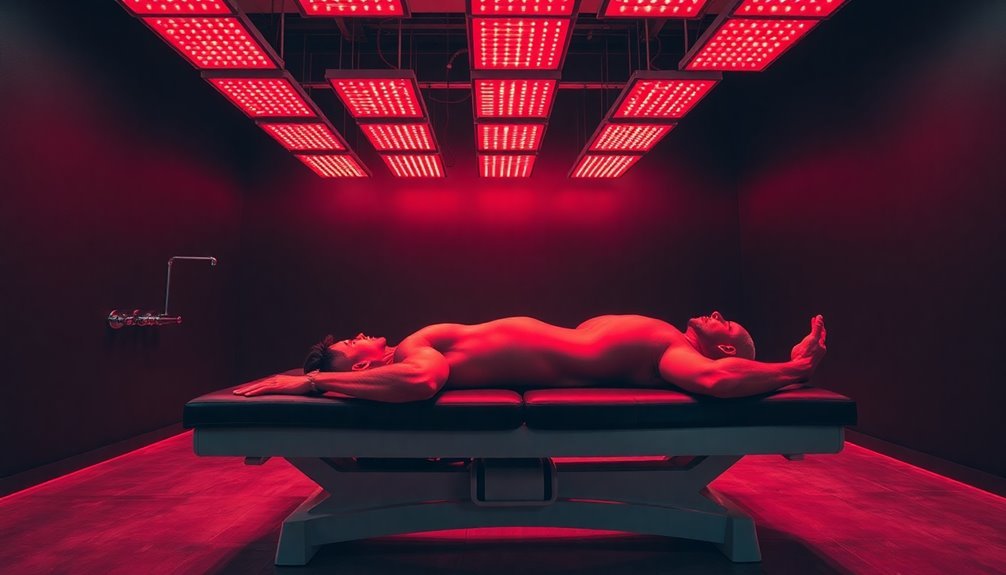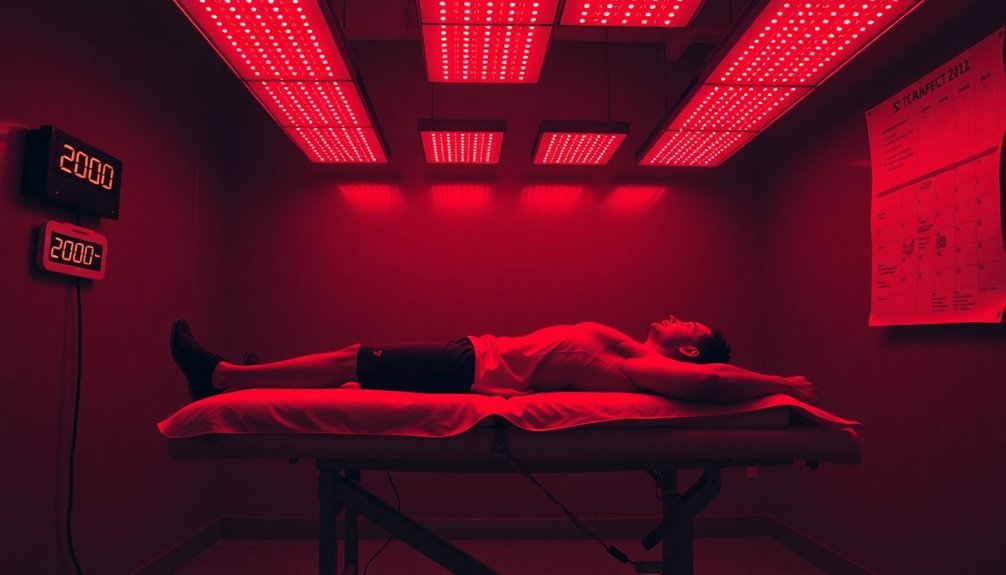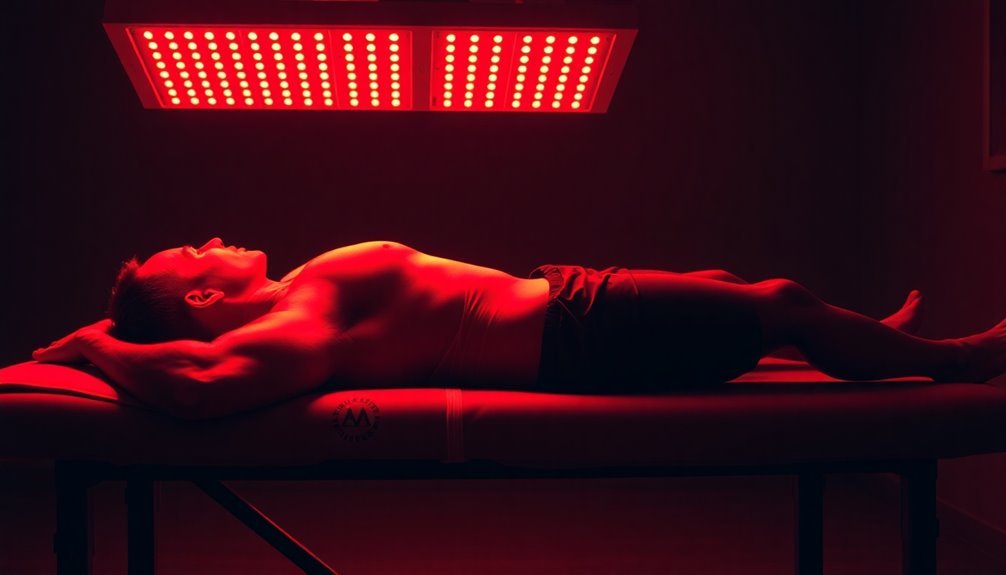Three evidence-based tips can maximize red light therapy's impact on your athletic recovery. First, schedule 10-15 minute pre-exercise sessions 3-6 hours before training to boost blood flow and prepare muscles for intense activity. Second, target your major muscle groups strategically – larger muscles like quads need 60-300 joules while smaller muscles require 20-60 joules per treatment. Third, maintain consistency with 3-5 weekly sessions spaced every other day for maximum results. By implementing these scientifically-backed techniques and understanding the proper timing, intensity, and frequency, you'll release red light therapy's full potential for enhanced performance and faster recovery.
Pre-Exercise Light Therapy Sessions

Through pre-exercise light therapy sessions, athletes can substantially enhance their workout performance and recovery potential. When you're exposed to red and near-infrared light 3-6 hours before training, your muscles receive increased blood flow and oxygen, preparing them for intense physical activity. The optimal light wavelength range spans from 630-1200 nanometers for maximum effectiveness.
You'll notice several immediate benefits from pre-workout light therapy. The treatment accelerates your muscle recovery by reducing post-exercise soreness and damage.
It also boosts your cellular energy production, which enhances muscle performance and reduces injury risk. You're getting improved circulation and better oxygenation to your muscles, while the therapy acts as an antioxidant to decrease exercise-induced oxidative stress.
For the best results, you'll want to use a combination of red and near-infrared light, delivering up to 60 Joules per session. Whether you're an endurance athlete or focusing on strength training, consistent pre-exercise light therapy sessions will improve your muscle efficiency and boost strength gains.
The treatment helps prevent injuries by increasing muscle resilience and reducing inflammation. You'll experience enhanced athletic performance, better endurance, and faster recovery times when you incorporate this therapy into your pre-workout routine.
Target Major Muscle Groups
According to clinical research, targeting specific muscle groups with red light therapy requires different treatment approaches based on muscle size and function. You'll need to adjust your treatment intensity and duration depending on whether you're targeting large muscles like quadriceps and hamstrings or smaller ones like biceps and triceps.
For your larger muscle groups, particularly in the thighs, you'll want to apply higher doses ranging from 60-300 joules per treatment. Smaller muscles in your arms require less intensity, typically 20-60 joules per treatment.
You should maintain sessions for at least 15 minutes and repeat them several times weekly for best results. Red light therapy stimulates mitochondrial function to enhance muscle performance and recovery.
Your core muscles, including abdominals and lower back, are vital targets as they provide overall stability and enhanced performance. While red light therapy has proven particularly effective for reducing soreness in calf muscles, it's worth noting that not all muscle groups respond equally.
For instance, muscles involved in vertical jump exercises show limited improvement.
To maximize benefits, focus on major muscle groups used in your specific training routine, whether it's endurance or strength-based. The therapy aids cellular regeneration and reduces inflammation, helping your muscles recover faster from intense workouts and injuries.
Maintain Consistent Treatment Schedule

Establishing a consistent treatment schedule maximizes red light therapy's effectiveness for athletic recovery. You'll need 3-5 sessions weekly, spaced every other day to allow your body to respond effectively to the treatment. For intense training periods, you may benefit from more frequent sessions to support muscle recovery. Stimulating cellular energy production helps athletes recover faster by enhancing mitochondrial function and ATP generation.
Your sessions should typically last 10-15 minutes, though you can extend them to 20 minutes if you don't experience any adverse reactions. If you're new to red light therapy or have light sensitivity, start with shorter sessions and gradually increase duration based on your comfort level.
| Training Level | Session Frequency | Session Duration |
|---|---|---|
| Light Activity | 3x per week | 10-15 minutes |
| Moderate Training | 4x per week | 15-20 minutes |
| Intense Training | 5x per week | 15-20 minutes |
Remember to adjust your treatment plan based on your specific needs and training intensity. You'll see the best results by maintaining consistency with your sessions rather than using the therapy sporadically. For chronic pain or particularly demanding training periods, you might benefit from longer sessions, but always monitor your body's response.
Frequently Asked Questions
Can Red Light Therapy Help With Old, Chronic Sports Injuries?
Yes, you'll find red light therapy effective for old sports injuries. It reduces chronic inflammation, speeds up tissue repair, improves muscle function, and provides pain relief by increasing blood flow and cellular regeneration.
What Wavelengths of Red Light Are Most Effective for Athletic Recovery?
You'll get the best athletic recovery results using wavelengths between 630-700 nm for surface tissue repair and 700-1200 nm for deeper muscle healing. The 808 nm wavelength is particularly effective for muscle recovery.
Is It Safe to Combine Red Light Therapy With Other Recovery Methods?
Yes, you can safely combine red light therapy with other recovery methods like massage or ice baths. However, you'll need professional guidance and should follow safety protocols to avoid adverse effects or counterproductive interactions.
How Long Does It Take to See Results From Red Light Therapy?
You'll notice immediate relaxation after your first session, with visible skin improvements in 1-2 weeks. For lasting results in pain relief and deeper healing, expect 4-12 weeks of consistent treatment sessions.
Can Red Light Therapy Prevent Future Sports Injuries?
Yes, you'll reduce your risk of future sports injuries through red light therapy. It strengthens your muscles, decreases inflammation, and enhances tissue repair. Regular sessions help prevent strains and support faster recovery.
In Summary
You'll find red light therapy to be a game-changer for your athletic recovery when you follow these three key steps. By scheduling pre-workout sessions, focusing the light on your primary muscle groups, and sticking to a regular treatment routine, you're setting yourself up for faster healing and better performance. Make these practices part of your fitness regimen to maximize the benefits of red light therapy.





Leave a Reply